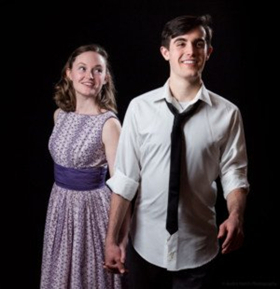Review: City Theater's THE LIGHT IN THE PIAZZA Shimmers

Biddeford's City Theater rises radiantly to the challenge of producing the infrequently done, butexquisitely beautiful musical, The Light in the Piazza. The Craig Lucas/Adam Guettel work offers a luminous, quasi-operatic, through composed score, and requires a deft and delicate touch to bring the story and characters to life. Director Linda Sturdivant and her excellent company have done just that with restraint, taste, and soaring lyricism.
Set in Florence and Rome in 1953, The Light in the Piazza explores the inner worlds of a mother and daughter as they seek love amid confusing cultural currents and the baggage of past pain. The work requires a tight knit ensemble with considerable vocal and dramatic talents, not the least of which is being able to create the genuine sense of two worlds - that of the Naccarellis and the Johnsons. That a considerable portion of the musical is actually spoken and sung in Italian adds another challenge for the company.
Linda Sturdivant understands that this is truly a chamber work that needs a subtle touch, and she keeps the staging fluid without ever being busy. She balances the climactic moments with the quiet ones, and she insures that the characters project warmth and passion without ever becoming stereotypes. Music Director Sara Sturdivant shapes the complex score with great skill. She elicits lovely, lyrical performances from the vocalists and leads the instrumental chamber ensemble confidently. The orchestrations, which rely heavily on harp and other strings, benefit especially from the lovely playing of harpist Mo Nichols. Mariel Roy choreographs the musical staging, making it flow seamlessly.
Karl Carrigan's set manages to evoke both scale and simplicity. The piazza is dominated by moveable arches that can then frame other locales; the large statue (presumably of David, though seen from the rear) creates a sense of wonder. The various other moveable units are elegantly done, though a few overly long scene changes create awkward moments of silence in the musical and dramatic narrative. Joseph Strout's lighting captures perfectly the ochres, pinks, and warm pastels of Tuscany. Light is a metaphor throughout, and Strout's design makes the most of this. Hannah Brown provides the simple yet attractive period costumes. Todd Hutchisen's sound design struggles with some of the opera house's technical difficulties, and sometimes the acoustic seems unbalanced or displeasingly hard in sound. Dialect Coach Tim Steiner has done an excellent job with the cast, especially with all those required to speak in Italian or accented English.
 The cast is an accomplished one both vocally and dramatically. As Margaret Johnson, Rebecca Rinaldi gives a finely nuanced performance - both overbearing and vulnerable, and she is a commanding vocal presence, most notably n her long final soliloquy, "Fable." As her daughter Clara, Jacklyn Griggs brings a youthful freshness and impetuosity to the role. Her lovely lyric soprano captures the flickering intensity of the girl's emotions, and she is impressive in both her tirades and her more poetic moments like the title song, "The Light in the Piazza."
The cast is an accomplished one both vocally and dramatically. As Margaret Johnson, Rebecca Rinaldi gives a finely nuanced performance - both overbearing and vulnerable, and she is a commanding vocal presence, most notably n her long final soliloquy, "Fable." As her daughter Clara, Jacklyn Griggs brings a youthful freshness and impetuosity to the role. Her lovely lyric soprano captures the flickering intensity of the girl's emotions, and she is impressive in both her tirades and her more poetic moments like the title song, "The Light in the Piazza."
Miles Obrey turns in a stunning performance as Fabrizio. Not only does he bring to the part a convincingly dashing, Italianate quality, but he is absolutely pitch perfect in his accented English, flawless in his Italian language - both spoken and sung. Vocally, his musical, refined lyrical tenor soars in the music, while his songs like "Il Mondo Era Vuoto," "Aiutami, and his two big romantic moments, "Say It Somehow" and "Love To Me" are exquisitely sung.
Brian McAloon makes a convincing Signor Naccarelli - demanding, dignified, and yet likeable patriarch - and he adds his rich voice to the mix. As his wife, Shauna Lucas shines in her witty "translation" of the "Octet." Owen White gives a convincing portrayal of the older son, Giuseppe, with Mary Lettelier delivering some powerful moments as his tempestuous wife, Franca, whose solo, "The Joy You Feel" is one of the show's highlights. As Roy Johnson, Margaret's distant husband, Tim Steiner makes the most of his scenes, while Adam Gary Norman is effective as the Priest, especially in the chaotic wedding scene. The eleven-member ensemble rounds out the narrative, moving gracefully through the scenes as a kind of chorus.
This is not the first time City Theater has mounted a sophisticated and complex newer work, but this production of The Light in the Piazza surely raises the bar for challenges confronted and mastered. Maine theatregoers should be grateful for this opportunity to see one of the gems of the modern musical repertoire performed so incandescently.
Photos courtesy of the City Theater, Audra Hatch, photographer
The Light in the Piazzaruns from March 8-24, 2019 at Biddeford's City Theater, 205 Main St., Biddeford, ME www.citytheater.org 207-282-0849
Reader Reviews

Videos

